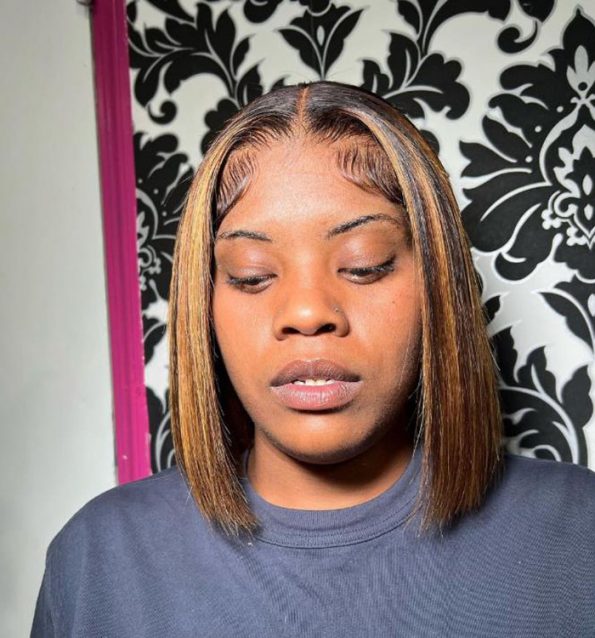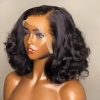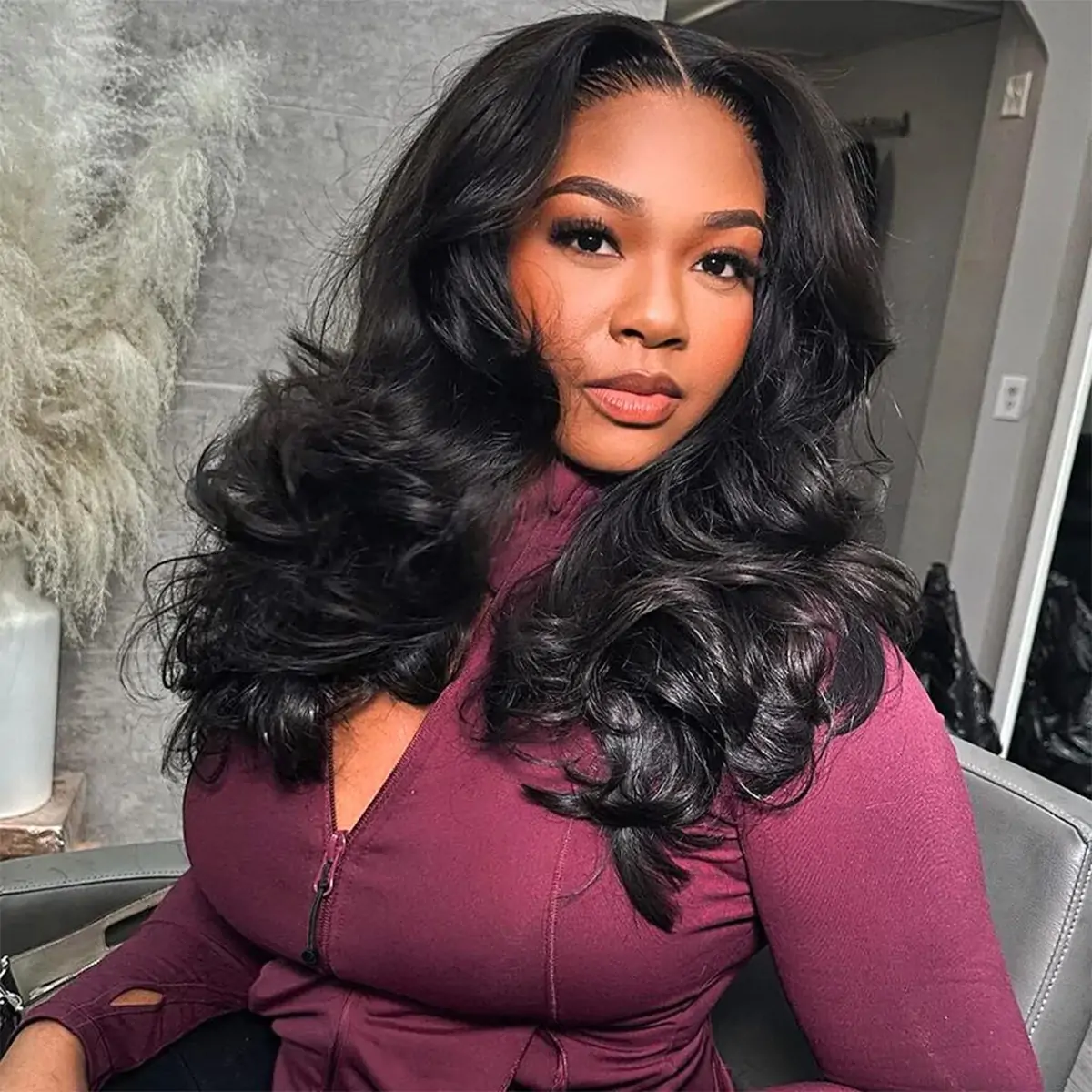Highlighted wigs offer a unique and vibrant look. However, one common challenge is blending the wig seamlessly with natural hair. Achieving a natural-looking blend is crucial to ensuring a flawless appearance. In this article, we will guide you through the process of blending highlighted wigs with natural hair, covering various techniques, tips, and tricks to help you achieve a stunning and cohesive look.

Preparing Natural Hair for Blending with Highlighted Wigs.
When it comes to blending a highlighted wig with your natural hair, proper preparation is key. Taking the time to prepare your natural hair before applying the wig will help ensure a seamless and natural-looking blend.
Wash and Condition:
Start by washing your hair thoroughly with a gentle shampoo and conditioner. This will remove any product buildup, dirt, or oils that could affect the blending process. Choose products that are suitable for your hair type and avoid using heavy conditioners that may weigh your hair down.
Moisturize and Detangle:
After washing, apply a leave-in conditioner or moisturizing product to hydrate your hair. This will help maintain its health and prevent it from drying out while wearing the wig. Use a wide-tooth comb or a detangling brush to gently remove any knots or tangles, starting from the ends and working your way up to the roots.
Trim Split Ends:
If your hair has split ends, it’s essential to trim them before blending with a wig. Split ends can make the overall appearance look unkempt and less polished. Regular trims will keep your natural hair in good condition and ensure a smooth blend with the wig.
Consider Hair Texture:
The texture of your natural hair plays a significant role in achieving a seamless blend with a wig. If your hair is naturally curly, consider straightening it using a flat iron or blow dryer for a smoother transition. On the other hand, if you have straight hair, you may want to add some curls or waves to match the texture of the wig.
Hair Color Matching:
To achieve a natural-looking blend, it’s important to consider the color of your natural hair and match it to the highlighted wig. If the colors are too contrasting, it can create an unnatural and noticeable line of demarcation. Look for a wig that closely matches your natural hair color, or consider dyeing your natural hair to match the wig color if necessary.
Style Appropriately:
Before applying the wig, style your natural hair in a way that will facilitate a seamless blend. This could involve braiding or twisting your hair, creating a flat foundation to anchor the wig securely. Avoid bulky or high hairstyles that may create an unnatural shape or bulge under the wig.
Protect Your Natural Hair:
Wearing a wig for extended periods can put some strain on your natural hair. To protect it, consider using a wig cap or a protective style, such as cornrows or flat twists. This will provide a barrier between the wig and your hair, reducing friction and potential damage.
Preparing the Wig for Blending with Natural Hair.
To achieve a seamless blend between a wig and your natural hair, proper preparation of the wig is essential. This involves customizing the wig to match your natural hair color, texture, and style. Here are some steps to follow when preparing the wig:
Trim the Wig:
Most wigs come with excess length, so it’s important to trim the wig to your desired length. Start by securing the wig on a wig stand or mannequin head and carefully trim the ends using sharp scissors. Take small sections at a time to ensure even cutting. Remember to step back and assess the length as you go to avoid cutting too much.
Thin the Wig:
If the wig is too thick or has a lot of volume, thinning it can create a more natural appearance. Use thinning shears or a razor comb to remove excess hair. Take small sections of the wig and gently blend the scissors or razor comb through the hair, focusing on the ends and areas that appear bulky. This will help reduce the density and create a more seamless blend with your natural hair.
Style the Wig:
Styling the wig to match your natural hair is an important step in achieving a seamless blend. If your natural hair has a particular texture or wave pattern, you can style the wig to match. Use heat tools, such as curling irons or flat irons, to add curls, waves, or straighten the wig as needed. Take small sections and be mindful of the heat settings to prevent damage to the wig fibers.
Customize the Hairline:
To create a more realistic hairline, you can customize the wig’s front edge. If it’s a lace front wig, carefully trim the lace to match your natural hairline. Start by securing the wig on your head and use small scissors to carefully cut along the lace, following the shape of your hairline. Take your time and make small cuts to avoid cutting too much. If necessary, you can also pluck a few hairs from the wig’s hairline to create a more natural look.
Match the Scalp Color:
The color of the wig’s scalp or wig cap should closely match your own scalp color for a realistic appearance. If the wig’s cap is visible, you can use makeup or special wig scalp powders to match the color. Apply a small amount of powder to a brush or sponge and gently pat it onto the exposed areas of the wig cap, blending it carefully. This will help create the illusion of a natural scalp.
Secure the Wig:
To ensure the wig stays in place and blends seamlessly with your natural hair, it’s important to secure it properly. There are several methods you can use, including wig clips, adhesive tapes, or wig glue. Wig clips can be sewn into the wig cap to provide additional stability. Adhesive tapes and wig glue can be used to secure the wig to your scalp. Follow the instructions provided with the adhesive products and apply them carefully to avoid any discomfort or damage to your natural hair.
Test and Adjust:
Once you have prepared the wig, wear it and examine it closely in different lighting conditions. Check for any uneven cuts, unnatural textures, or visible wig cap lines. Make any necessary adjustments to ensure a seamless blend. If you are unsure about any aspect of the preparation, seek assistance from a professional wig stylist who can help you achieve the desired look.
Applying the Wig.
Applying a wig correctly is crucial for achieving a seamless blend with your natural hair. When done properly, it will ensure that the wig looks natural, stays secure, and blends seamlessly with your own hair. Follow these steps to apply the wig:
Prepare Your Natural Hair:
Before applying the wig, make sure your natural hair is prepared properly. If your hair is long, consider braiding it or creating a flat foundation by cornrowing it close to the scalp. This will provide a smooth surface for the wig to sit on and help prevent any lumps or bumps. For shorter hair, use bobby pins or a wig cap to flatten it against the scalp.
Put on a Wig Cap:
To create an even surface and hold your natural hair in place, put on a wig cap that matches your scalp color. This will help keep your hair secure and prevent it from peeking out underneath the wig. Stretch the wig cap over your head, ensuring that all your hair is neatly tucked inside. Adjust the cap so that it fits snugly and comfortably.
Position the Wig:
Hold the wig by the nape area with both hands, with the label at the back. Tilt your head forward and position the front edge of the wig above your forehead, aligning it with your natural hairline. Gently slide the wig over your head, allowing the back of the wig to fall into place. Use your fingers to adjust the wig and ensure it’s centered and aligned correctly.
Secure with Wig Clips:
If your wig has built-in wig clips, use them to secure the wig in place. Lift a section of your natural hair and locate the openings of the wig clips. Snap the clips shut, securing them to the wig cap and your natural hair. Repeat this process for each wig clip, making sure they are evenly distributed around the wig’s perimeter for a secure fit.
Apply Adhesive (If Necessary):
If you prefer a more secure hold or have a full lace wig, you can use adhesive to attach the wig to your scalp. Apply a thin layer of wig adhesive or glue along your natural hairline, using a small brush or applicator. Allow the adhesive to become tacky according to the instructions provided. Carefully press the lace or front edge of the wig onto the adhesive, starting from the center and working your way outwards. Gently smooth down the wig to ensure a secure bond.
Adjust and Style:
Once the wig is secure, adjust it to ensure a natural and comfortable fit. Use a mirror to check that the wig sits evenly on your head, with no visible gaps or edges. Adjust the position if needed. If the wig has lace at the front, use a small pair of scissors to carefully trim any excess lace, being cautious not to cut into the hairline.
Blend the Natural Hair and Wig:
To achieve a seamless blend between your natural hair and the wig, use a wide-tooth comb or your fingers to gently blend the natural hair with the wig’s hair. Comb or blend the hair at the hairline to create a smooth transition. If necessary, use a styling tool, such as a flat iron or curling wand, to match the texture of your natural hair with the wig. Style the wig as desired, ensuring it looks cohesive with your natural hair.
Final Touches:
After applying the wig, use a mirror to examine the overall appearance. Make any necessary adjustments to ensure a natural and comfortable fit. Check for any visible wig cap lines or unevenness. Gently pat down any areas that may be lifting or not sitting flat against the scalp. Consider adding accessories, such as headbands or scarves, to further enhance the blend and personalize your look.
Blending Techniques.
Blending a highlighted wig with your natural hair requires techniques that create a smooth transition, ensuring a seamless and natural-looking blend. The goal is to make the wig and natural hair appear as one cohesive unit. Here are several blending techniques to help you achieve a flawless result:
Backcombing/Teasing:
Backcombing or teasing the hair at the roots can create volume and texture, helping to blend the wig and natural hair seamlessly. Take small sections of your natural hair near the hairline and, using a fine-tooth comb, gently comb downward towards the scalp. This technique adds texture and creates a base for the wig to grip onto, resulting in a more secure and natural blend.
Braiding or Twisting:
Braiding or twisting your natural hair can be an effective way to blend it with a wig, especially if you have longer hair. Create small braids or twists close to the scalp, starting from the hairline and working backward. This technique provides a flat foundation and reduces bulk, allowing the wig to sit smoothly on top. Secure the ends of the braids or twists with small elastics or bobby pins for added security.
Half-Up Hairstyles:
A half-up hairstyle can help blend your natural hair with a wig while adding a stylish touch. Gather the top half of your natural hair and secure it with a hair tie or clip, leaving the bottom half loose. This technique creates a smooth transition between the wig and your natural hair, allowing them to blend seamlessly. You can also add some volume or texture to the top section of hair for added dimension.
Hair Accessories:
Using hair accessories can aid in blending the wig with your natural hair. Headbands, scarves, or hair clips strategically placed along the hairline can help conceal any visible lines and create a seamless blend. Opt for accessories that match your style and complement the colors in the wig. Experiment with different placement options to find the most flattering and natural-looking result.
Balayage or Ombre Coloring:
If your natural hair color differs from the highlighted wig, consider incorporating balayage or ombre coloring techniques. These coloring techniques involve adding subtle highlights or gradually transitioning the color from darker at the roots to lighter towards the ends. Matching the color of the wig’s highlights with the balayage or ombre effect in your natural hair can create a beautiful blend and minimize any noticeable color discrepancies.
Color-Matching Products:
To enhance the color blend between the wig and your natural hair, you can use color-matching products. Temporary color sprays, powders, or root touch-up products that closely match the wig’s color can be applied to your natural hair near the hairline. These products help camouflage any visible contrast, ensuring a seamless integration between the wig and your own hair.
Styling Tools and Techniques:
Using styling tools, such as curling irons, flat irons, or hot rollers, can help create consistent texture and curl patterns that match the wig. Style your natural hair and the wig together, so they blend seamlessly. For example, if the wig has loose waves, add similar waves to your natural hair to achieve a unified look. This technique ensures that both the wig and your natural hair have the same texture and complement each other.

All in all.
Blending a highlighted wig with natural hair may seem daunting, but with the right techniques and knowledge, it can be achieved seamlessly. By following the steps outlined in this article, you will be able to create a stunning and cohesive look that combines the beauty of your natural hair with the versatility of highlighted wigs. Remember, practice and experimentation are key to finding the techniques and styles that work best for you. Embrace your creativity and enjoy the endless possibilities that highlighted wigs can offer.
















